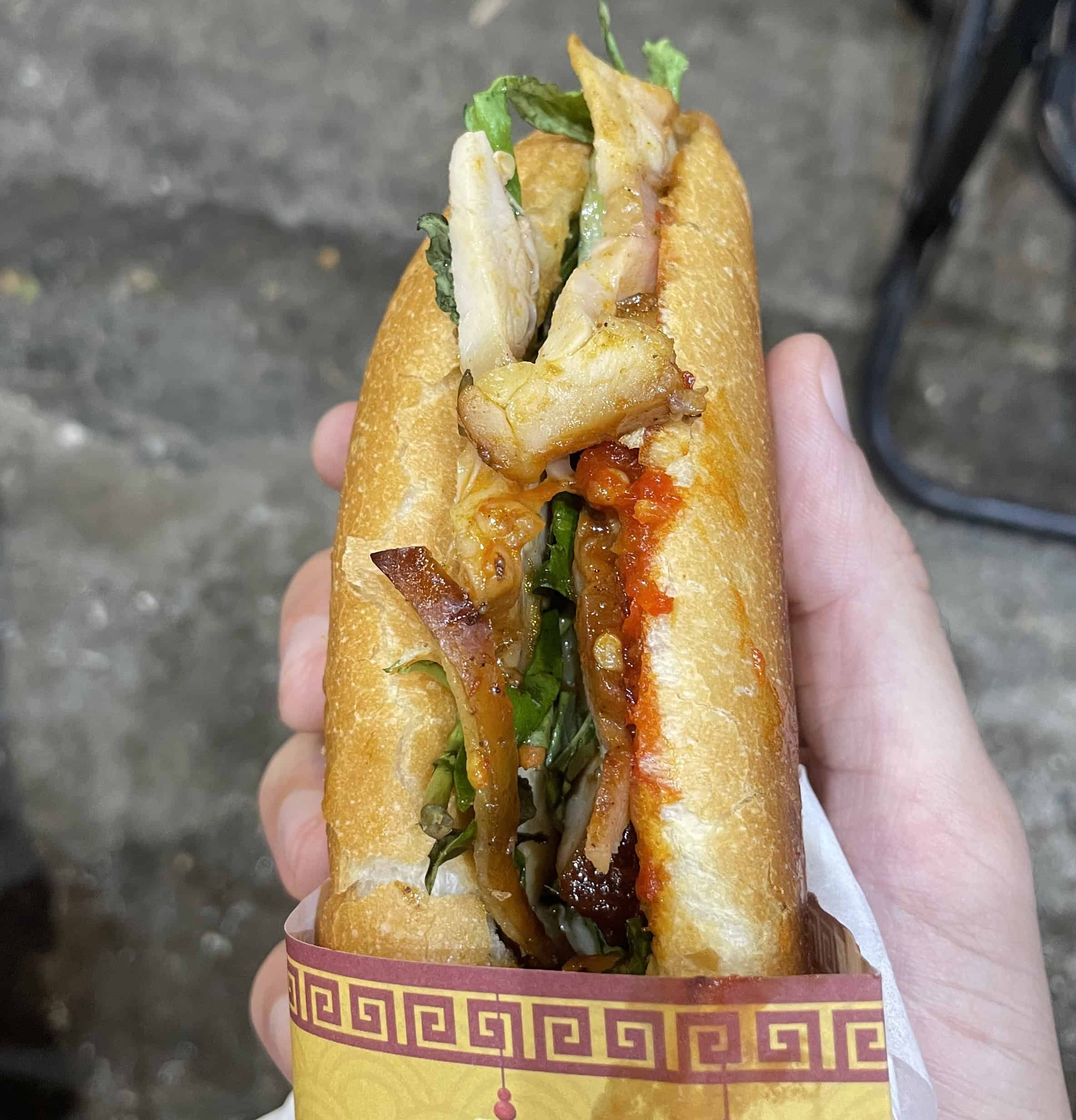Best Banh Mi in Vietnam: Saigon, Hoi An & Hanoi
If you’re heading to Vietnam, there’s one street-food you absolutely can’t leave without trying: banh mi.
This iconic Vietnamese sandwich is one of the country’s most beloved (and affordable) bites, crispy on the outside, soft inside, and packed with bold, fresh flavors.
While its roots trace back to French colonial influence (yes, the baguette is the giveaway), banh mi has evolved into something uniquely Vietnamese.
Over time, local ingredients, spices, and creativity turned this once-French bread into a national obsession.
Having grown up in Toronto, I’ve eaten banh mi my entire life. It’s been a go-to meal for many years for me, it’s refreshing, flavorful, and filling without being heavy.
During my many visits to Vietnam over the years, I’ve tried more banh mi spots than I can count, there have been weeks where I’ve had it every single day, sometimes twice.
You could say I don’t just love banh mi, I’ve truly eaten my way through it across all regions of Vietnam.
In this guide, we’ll break down the best banh mi in Vietnam, from Saigon to Hoi An and Hanoi.
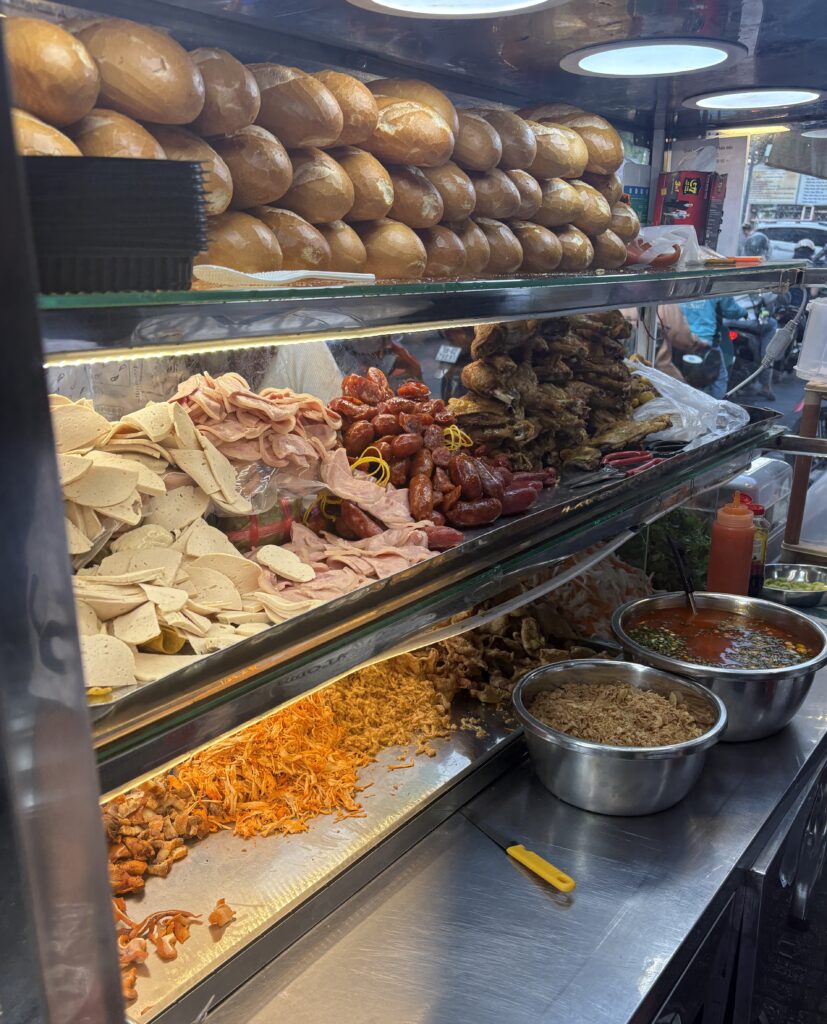
Regional Differences in Banh Mi: South vs Central vs North
Traveling between Vietnam’s three main regions isn’t just a shift in scenery, it’s a shift in how you’ll encounter its most iconic Vietnamese sandwich.
The baguette, fillings, sauces, and overall vibe vary considerably from Hanoi’s more restrained version to the bold, packed loaves of Saigon, with the central region offering its own unique balance.
Saigon (Southern Vietnam)
When most people think of banh mi, they’re picturing the southern-style version, and for good reason.
Saigon is where banh mi truly exploded in popularity and evolved into the stuffed, flavor-packed sandwich many of us know today.
The bread here is bigger, airier, with a crispy golden crust and a fluffy inside. The fillings are bold and generous: cold cuts, grilled pork, pork floss, pate, pickled vegetables, cucumber, cilantro, chili, and a heavy drizzle of soy or Maggi sauce. Every bite is balanced, rich, tangy, and herby
Saigon’s banh mi is a full-on meal, colorful, indulgent, and packed with variety. It’s often sold from push carts or tiny street stalls, and it’s an essential part of daily life.
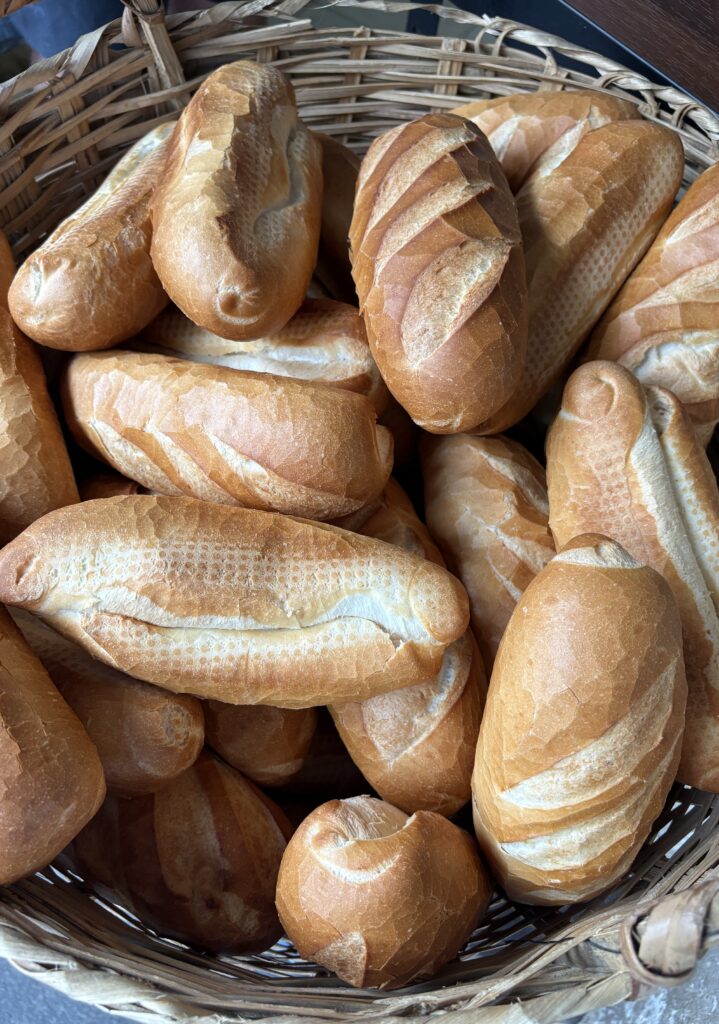
Central Vietnam (Hoi An, Da Nang, Hue)
Banh mi in Central Vietnam has its own signature flair, especially in Hoi An. The bread here is smaller, lighter, and often paler in color, with a more canoe-like shape at the ends. The crust is crisp, but the inside is a bit denser than the southern version.
What sets this region apart is the spice factor and seasoning. You’ll often find chili jam or sauce layered under grilled pork, pate, or sausage. The use of herbs is more restrained, and the fillings more focused.
Central-style banh mi doesn’t rely on the volume of ingredients but rather the intensity of flavor in each bite.
The size makes them great for snacking, and trust me, it’s hard to stop at one. A perfect afternoon in Hoi An for me is getting a banh mi and following it up with a bicycle ride to the beach.
Hanoi (Northern Vietnam)
Northern-style banh mi, particularly in Hanoi, is minimalist and refined. The bread is shorter and denser, with a chewier crust, not quite as airy as its southern cousin.
Fillings are simple: slices of pork ham (cha lua), a layer of pork liver pate, maybe some pork floss, and a dash of Maggi sauce.
Vegetables? Minimal. A few slices of cucumber, maybe some pickled carrot and daikon, but you won’t find a colorful heap of herbs. The flavor is more restrained, with fewer components competing for attention.
In the North, the focus is on texture and subtle taste. It’s less about the “wow” factor and more about a quiet appreciation for quality bread and classic ingredients.
Best Banh Mi in Saigon (Ho Chi Minh City)
Considered the birthplace of the banh mi, Saigon is where this iconic sandwich truly took off. It’s bold, flavorful, and generously stuffed, a perfect reflection of the city itself.
As you walk through central districts like District 1 or Ben Thanh, you’ll spot countless banh mi stalls and shops just meters apart, each with its own twist.
From grilled meats to classic cold cuts, Saigon’s banh mi scene is vibrant, diverse, and impossible to resist.
And if you’re still hungry after your sandwich tour, don’t miss trying Bo Kho and Bo Ne in Saigon, two other local dishes that bring the same punchy and satisfying flavors.
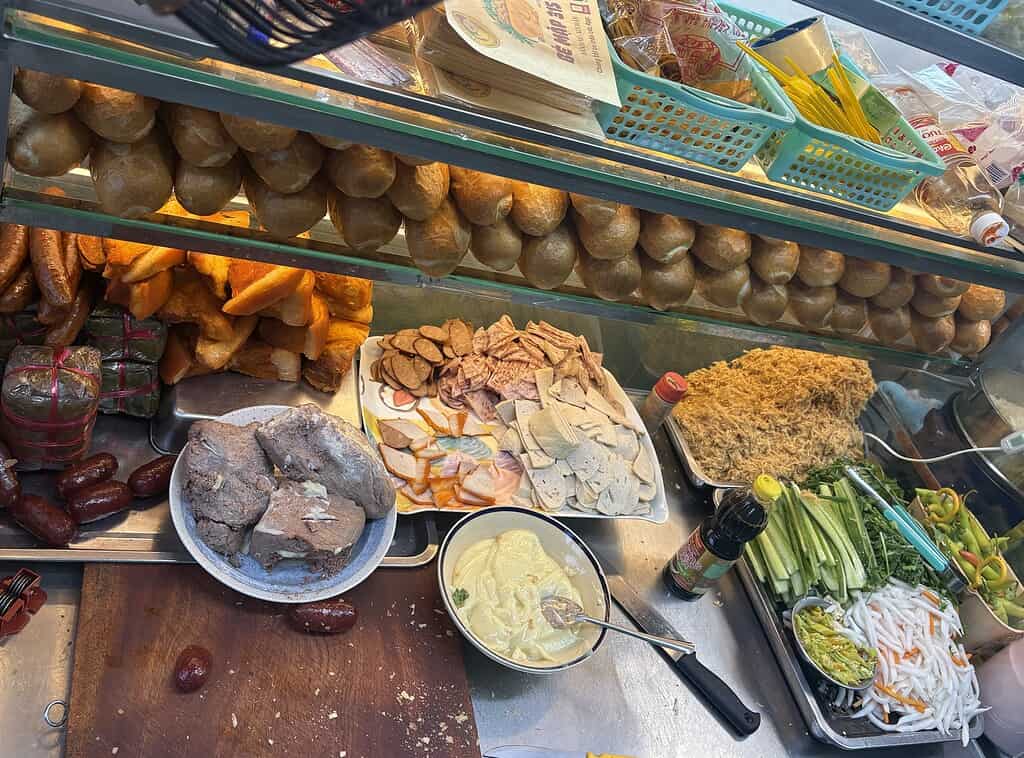
Banh Mi Bay Ho
This spot is one of the oldest, most iconic banh mi vendors in Saigon, a true local legend.
Tucked on Huynh Khuong Ninh Street in District 1, Banh Mi Bay Ho has been slinging sandwiches since the 1930s, and the operation still feels old-school in the best way.
They were briefly featured on Netflix’s Street Food show, but don’t let that fool you. This isn’t some overhyped, made-for-TV banh mi shop.
There’s no flashy storefront, just a simple setup with loyal regulars lining up for a taste of what many claim is one of the most authentic banh mi experiences in the city.
The bread is perfectly crisp, slightly golden, and filled with the essentials: house-made pork cold cuts, head cheese, and a generous slather of buttery pate.
The pickled vegetables are balanced, not overly sweet, and the green chili kick gives it that unmistakable southern punch.
That said, their beef banh mi, paired with sautéed onions, is a must-try. It’s juicy, savory, and full of flavor.
Don’t skip the drinks either. They offer a variety of coffee, fresh juices, and teas. My go-to here is a beef banh mi and a chilled lychee tea.
Banh Mi Hong Hoa
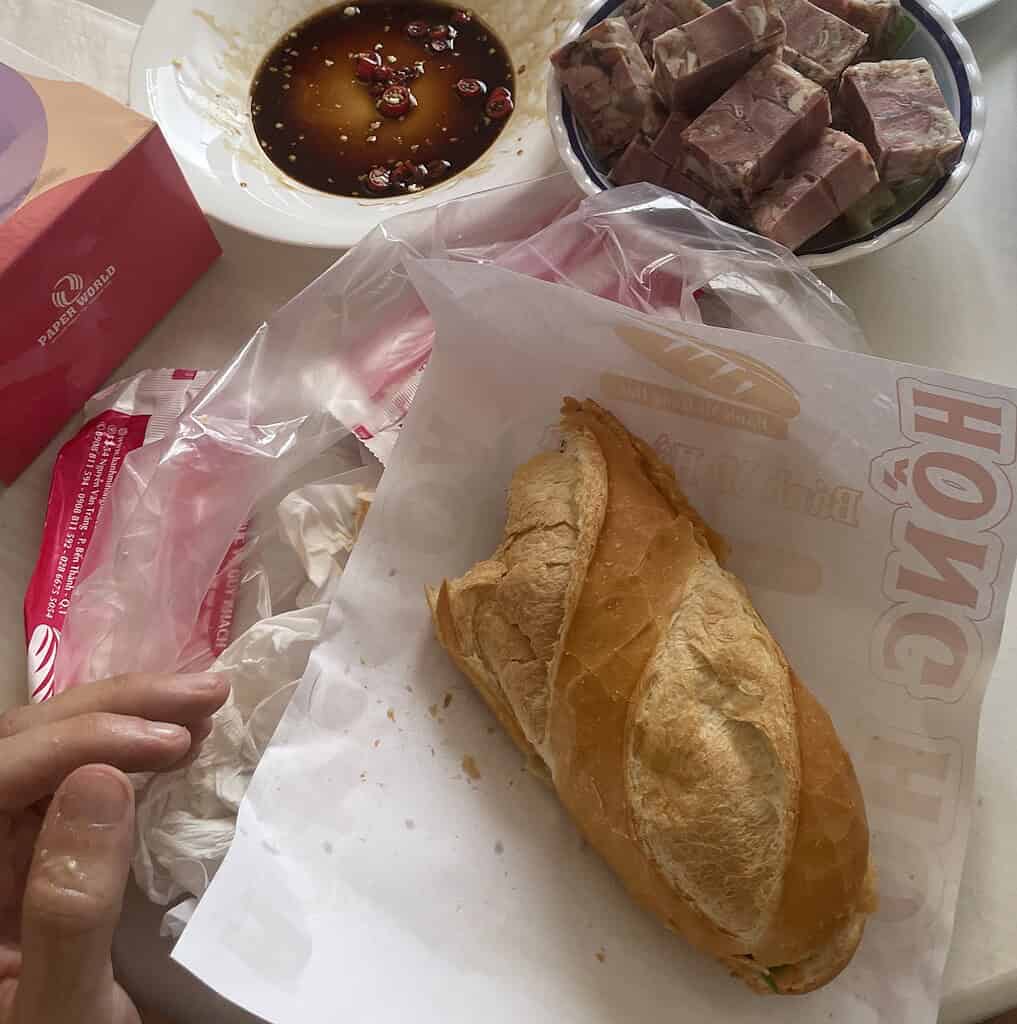
Banh Mi Hong Hoa is a Saigon staple, a spot that consistently lands on lists of the best banh mi in Vietnam, and for good reason.
This shop might be tucked away on a side street, but it regularly draws a crowd thanks to its generous fillings, crisp baguettes, and classic flavor combinations done right.
What sets this place apart is the sheer variety. You’ll find everything from BBQ pork to tuna, meatball, omelet, and even mixed meat banh mi.
One of my personal favorites is the spicy fish banh mi, packed with flavor. They also offer plenty of other grab-and-go items like dumplings and Vietnamese baked goods, making it feel more like a humble bakery than just a sandwich shop.
And speaking of bakery, this is where Banh Mi Hong Hoa truly shines. In my opinion, it’s number one in Saigon when it comes to the bread alone.
It’s always fresh, perfectly crisp, and light. I’ve seen bags and bags of loaves being dropped off throughout the day, and more than once, the aroma alone has convinced me to grab a second banh mi.
Banh Mi 37
If you’re after that sizzling, straight-off-the-grill street food energy, Banh Mi 37 should be high on your list.
What started as a humble pushcart operation has become one of the most buzzed-about banh mi stalls in Saigon, and for good reason.
Located on Nguyen Trai Street in District 1 (though the cart sometimes shifts slightly), this spot is famous for one thing: charcoal grilled pork meatball banh mi.
These juicy, smoky meatballs are freshly grilled over charcoal, then stuffed into a warm, crusty baguette along with cucumber, pickled carrots and daikon, cilantro, and their signature spicy-sweet sauce.
What sets Banh Mi 37 apart isn’t just the meatballs, it’s the balance. The bread is always fresh, the meat perfectly caramelized, and the sauce? Addictive.
You’ll likely have to wait in line, especially during the early evening hours, but the payoff is worth it. It’s street food at its finest: quick, flavorful, and unforgettable.
Best Banh Mi in Hoi An
Hoi An might be better known for its lantern-lit streets and tailor shops, but it’s also home to some of the most beloved banh mi in Vietnam.
Compared to Saigon, the banh mi here is a little more refined, the bread often slightly smaller, lighter, and with a distinct canoe-like shape on the ends. It’s about balance, not excess.
Despite the town’s size, you’ll find no shortage of banh mi shops, often clustered around the Ancient Town.
Whether it’s a spot made famous by TV or a quiet local favorite, Hoi An’s banh mi scene punches well above its weight.
Phi Banh Mi
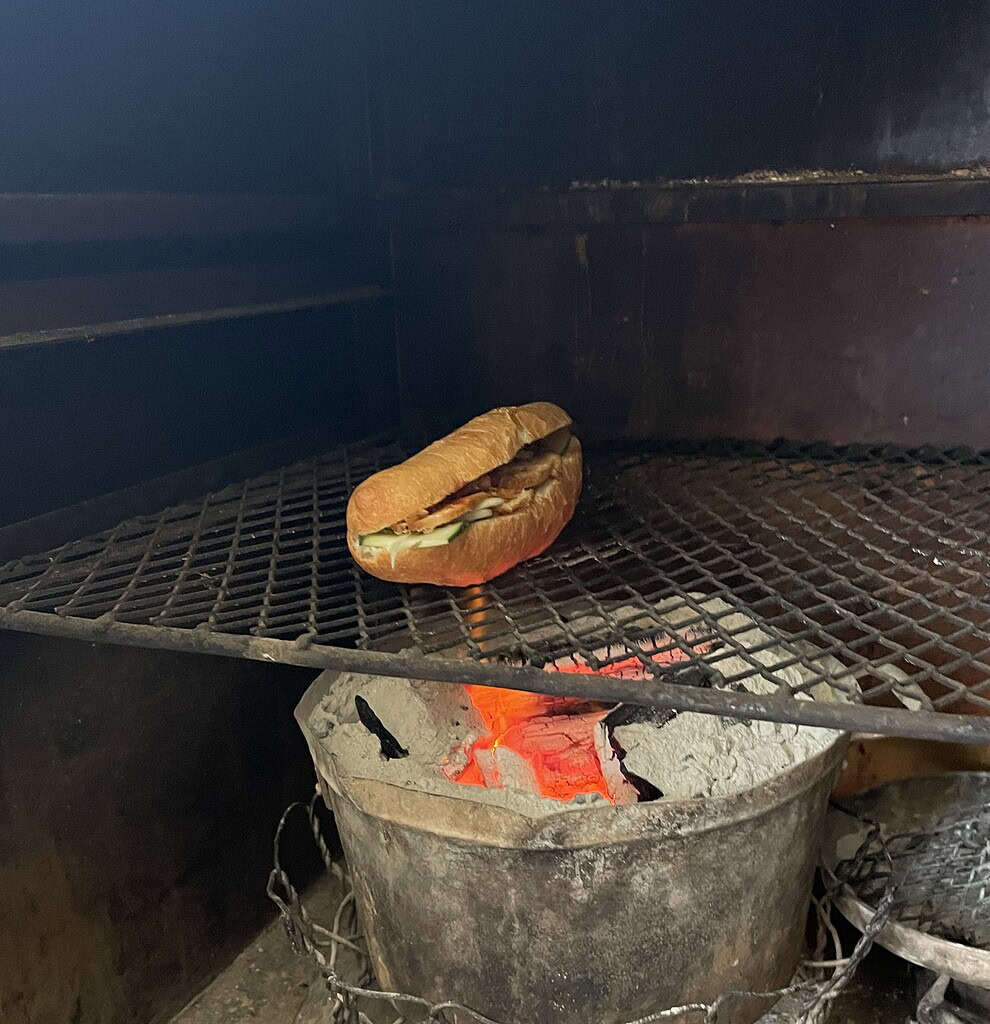
Phi Banh Mi might look humble from the outside, but it’s easily one of the most memorable banh mi spots in Hoi An, and not just because of the sandwich.
As soon as you arrive, you’ll notice it feels more like an extension of someone’s home than a commercial shop. A small cart is stationed out front where the owner prepares his tasty banh mi.
There are a few stools scattered around, a chalkboard menu, and a vibe that’s laid-back and genuine.
What really sets this place apart is the final touch he adds: every banh mi gets lightly toasted over hot charcoal before being handed to you. It’s a small detail that makes a big difference, warm, crispy bread with that faint smokiness you just don’t get at most spots.
While other shops may use charcoal ovens for baking, very few actually toast the full sandwich right before serving.
The sandwich options are solid, from egg and pork to tuna and chicken, and you can customize how you want it built. Oh, and don’t skip the drinks, the owner makes a great Vietnamese coffee.
One thing you probably won’t forget? The owner’s orange iguana sometimes sitting outside the shop sunbathing.
The owner told me once it was shipped from South America, and it’s since become part mascot, part conversation starter. At first glance, you might even think it’s fake, until it blinks back at you.
Banh Mi Phuong
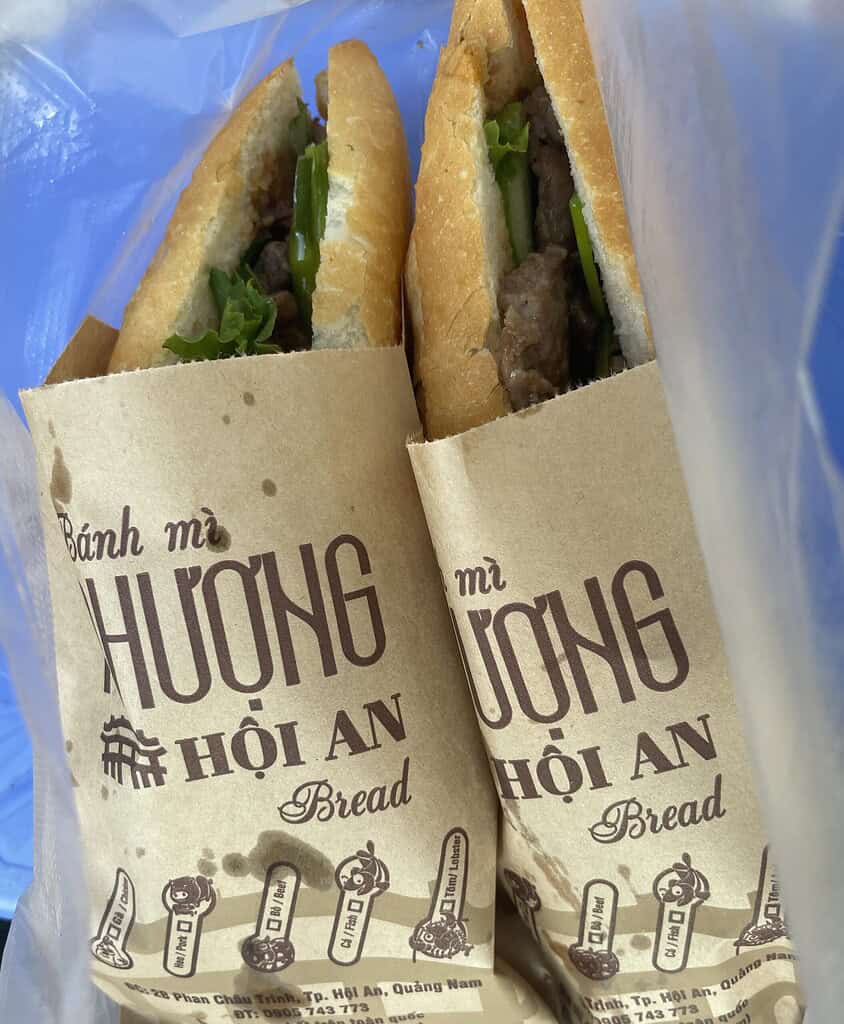
If there’s one banh mi shop in Hoi An that everyone knows, it’s Banh Mi Phuong. It’s iconic, ask any local, traveler, or street food lover, and this spot will come up almost instantly.
A big part of its fame came after being featured by the late Anthony Bourdain, who praised it during his visit to Hoi An.
But make no mistake, this isn’t just a “famous because it’s famous” kind of place. The sandwich absolutely holds up.
I’ve been back here countless times over the years, and the consistency is impressive. The bread is made in-house and toasted over hot charcoal, you’ll see the setup just behind the cashier. It comes out crisp, warm, and ready to cradle whatever filling you choose.
And the options? Endless. From barbecue pork and cold cuts to tofu and even omelet versions, you’ll find a sandwich to match your mood.
Watching the staff put them together is a show in itself, they move at lightning speed, expertly building custom banh mi after banh mi with chopsticks in hand.
Yes, the lines can be long, especially in the evenings. But they move quickly, and honestly, the energy of the place is part of the experience.
Banh Mi Phuong isn’t just a must-visit because it’s famous, it’s a must-visit because it’s damn good.
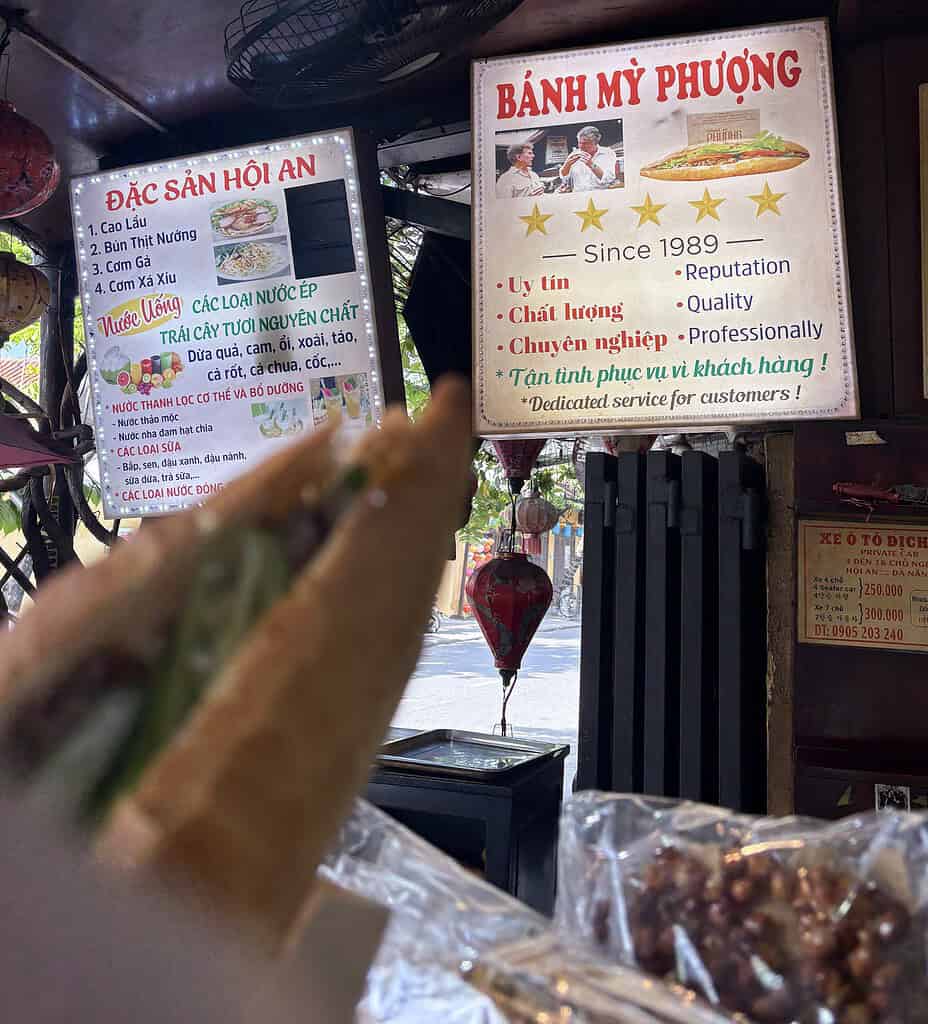
Banh Mi Sum
Banh Mi Sum is one of those under-the-radar spots that quietly earns a loyal following, and for good reason.
Tucked along the quieter streets of Hoi An, this humble shop doesn’t boast the long lines or global fame of others in town, but what it does deliver is a seriously tasty, well-balanced sandwich.
The menu isn’t overwhelming, but the flavor speaks volumes. Fillings are generous, the bread is perfectly crusty on the outside and soft on the inside, and everything is layered with care.
Their chicken banh mi, in particular, is a standout, flavorful, juicy, and paired with crunchy pickled veggies and herbs that cut through the richness beautifully.
One of the best things about Banh Mi Sum is the vibe. It’s a little more low-key, less touristy, and perfect for grabbing a banh mi and walking the lantern-lit streets of Hoi An. If you’re looking for a solid sandwich without the wait, this is your spot.
Best Banh Mi in Hanoi
Compared to its southern and central counterparts, banh mi in Hanoi leans simpler and more restrained, but that doesn’t mean it lacks flavor.
In fact, northern-style banh mi is all about balance, focusing on a few high-quality ingredients rather than stuffing the sandwich to the brim.
You’ll find denser bread with a thick crust, classic fillings like Vietnamese ham, pate, pork floss, or egg, and just a touch of herbs or pickled vegetables.
The sauces are minimal, maybe some butter or soy, allowing the ingredients and the bread itself to shine.
I’ll be honest, Hanoi’s banh mi is my least favorite of the three regional varieties. That said, what it might lack in sandwich creativity, it more than makes up for with its famous Hanoi pho.
Banh Mi 25
Banh Mi 25 is one of Hanoi’s most well-known banh mi spots, and for good reason.
While it’s located in the Old Quarter, it’s not the kind of place you just stumble across, you’ll likely need to seek it out, but it’s well worth the short walk.
The menu covers all the bases, BBQ pork, cold cuts with pate, chicken, tofu, egg, and even avocado for a lighter option.
The bread is slightly crusty and fresh, and though Hanoi’s style tends to be denser than its southern counterpart, it’s still satisfying and holds up well to the fillings.
When Banh Mi 25 first opened, it was just a humble street-facing stall. Over time, its popularity exploded, and now they’ve got a second setup directly across the street with extra seating.
It’s a great example of a local business growing organically, and quickly, thanks to quality and consistency.
Yes, it’s touristy. You’ll definitely spot plenty of other visitors lining up with you. But that doesn’t take away from the fact that this is still one of the best banh mi spots in Hanoi, and it consistently delivers.
Bami Bread
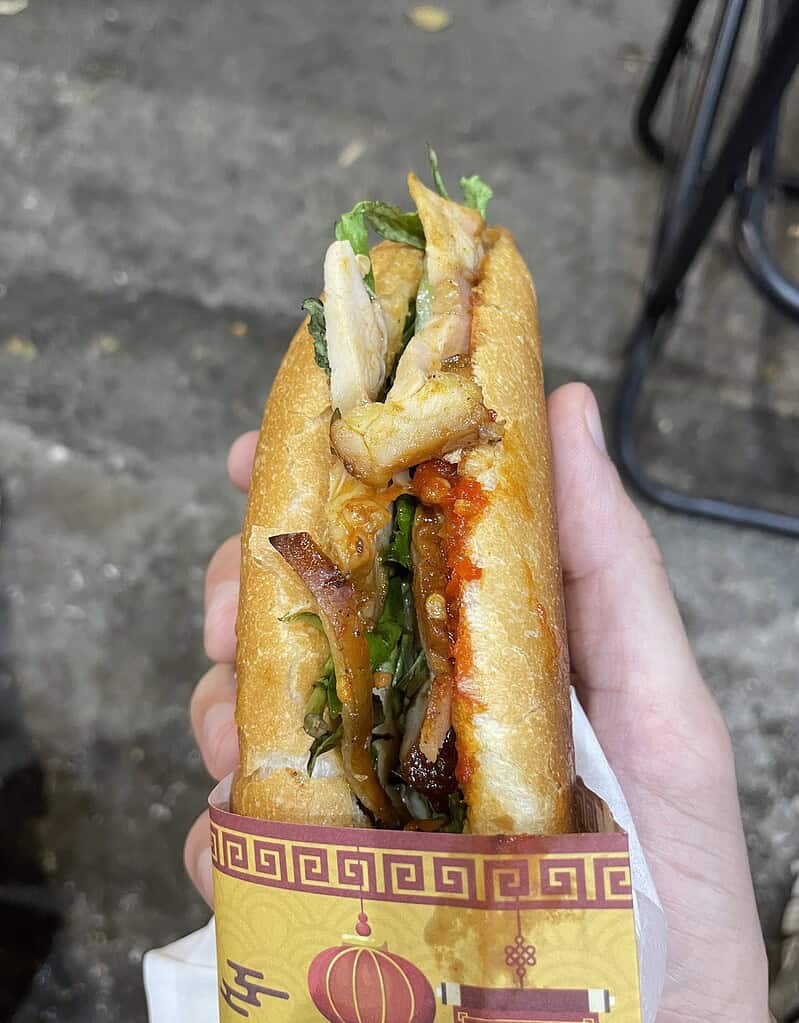
Bami Bread has to come in at a close second, and for some, it might just be the best banh mi in Hanoi.
Tucked in the heart of the Old Quarter, this spot is known for its crispy bread, creamy pate, and that rich, buttery Vietnamese-style mayo that gets slathered into every sandwich. By the way, they’ve got many locations, I just like going to the same one.
You’ll spot the small stall right away, streamlined, efficient, and always busy. Once you place your order, you’ll see the staff heat up each baguette before assembling, which is a small touch that makes a big difference.
Their BBQ pork with egg is especially popular, but my favourite has got to be the grilled chicken, they’ve got a range of fillings to choose from, all made fresh and quick.
What makes Bami Bread stand out is the consistency. It’s clean, well-run, and perfect for those who want a reliable banh mi without the chaos of a street corner vendor.
And once you’ve got your sandwich in hand, grab a seat outside and take in the controlled chaos of the Old Quarter, honking scooters, buzzing crowds, and that perfect, warm, crispy bun in hand.
Banh Mi Mama
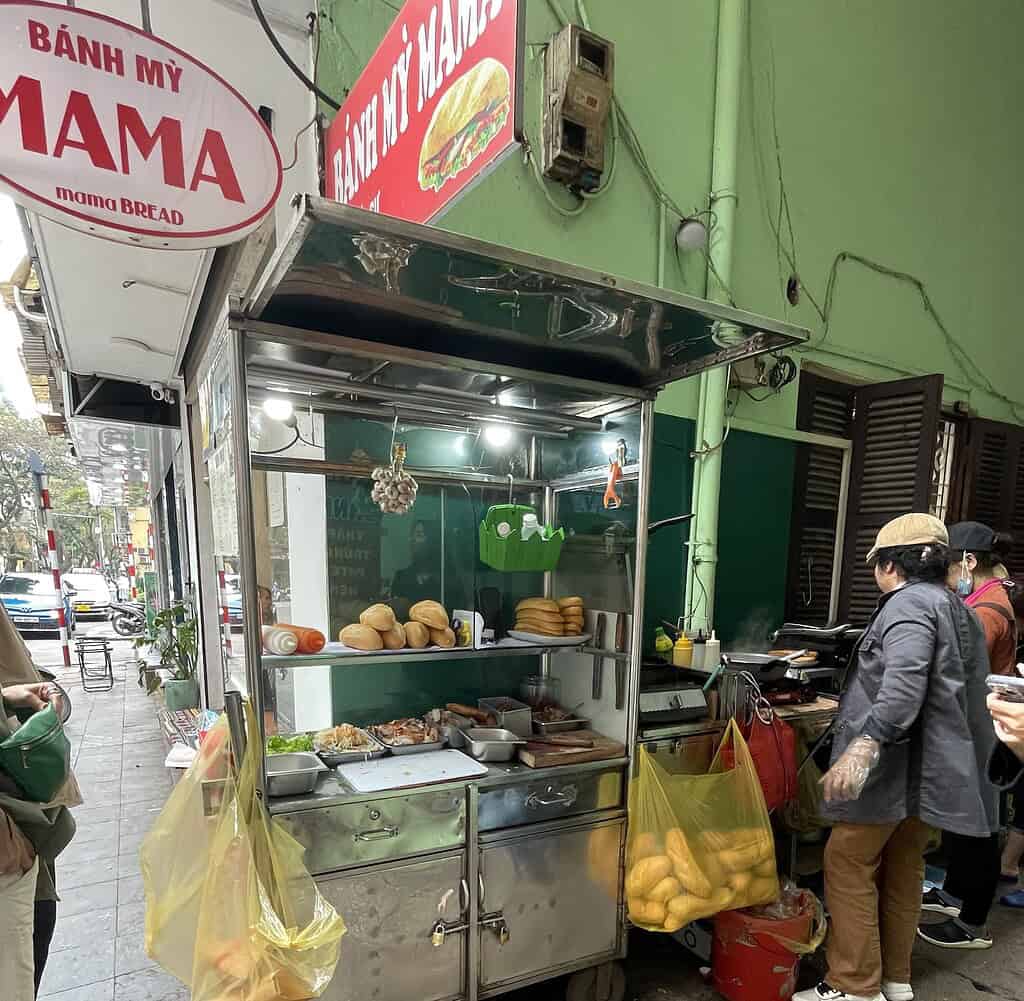
Banh Mi Mama is a Hanoi classic, no longer under-the-radar, but still serving some of the best banh mi in the city.
Located just beside St. Joseph’s Cathedral, this small alleyway cart might not look like much at first glance, but trust the line that often forms outside, it’s there for a reason.
Run by a pair of hardworking, friendly women, this little cart churns out banh mi after banh mi with speed and precision.
The stir-fried chicken is a go-to, the bread always hits that perfect crunchy-soft ratio, and the sauces add the right punch of flavor without overwhelming the sandwich.
It’s a quintessential Vietnamese street food experience, quick, flavorful, and served with a smile.
Whether you’re passing by the Cathedral or already on the hunt for a top-notch sandwich, Banh Mi Mama delivers every time.
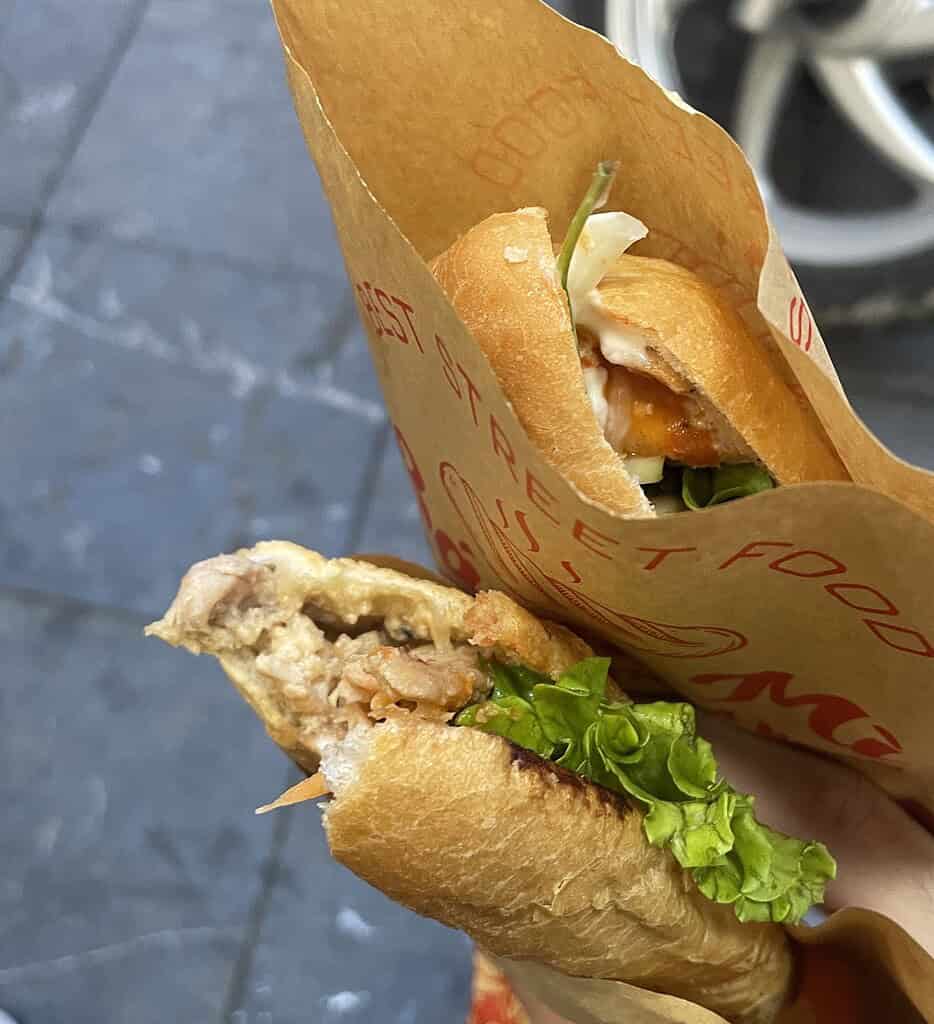
Tips for Eating Banh Mi in Vietnam
- Eat it Fresh: Banh mi is at its best right after it’s made. The crispy crust and warm fillings lose their charm if you leave it sitting around too long, so don’t save it for later unless you have no other option.
- Know the Basics in English (and Vietnamese): While many vendors are used to tourists, it helps to know some key meat terms:
– Thịt = pork
– Gà = chicken
– Bò = beef
– Pâté = traditional pork spread (often included by default)
If you don’t eat pork or pâté, make that clear, or choose a vegetarian option, which is available at many shops.
- Always Have Cash: Most banh mi stalls are small, cash-only operations. Prices are usually affordable, but having small bills (like 10k–50k VND) makes the transaction smooth and quick.
- Point & Smile: Even if there’s a language barrier, a friendly attitude goes a long way. Most stalls have their ingredients on display, you can easily point to what you want or don’t want.
- Customize It Your Way: Don’t be shy to ask for no corriender, extra sauce, or to swap in different proteins. Many stalls are flexible and used to tailoring sandwiches to different tastes.
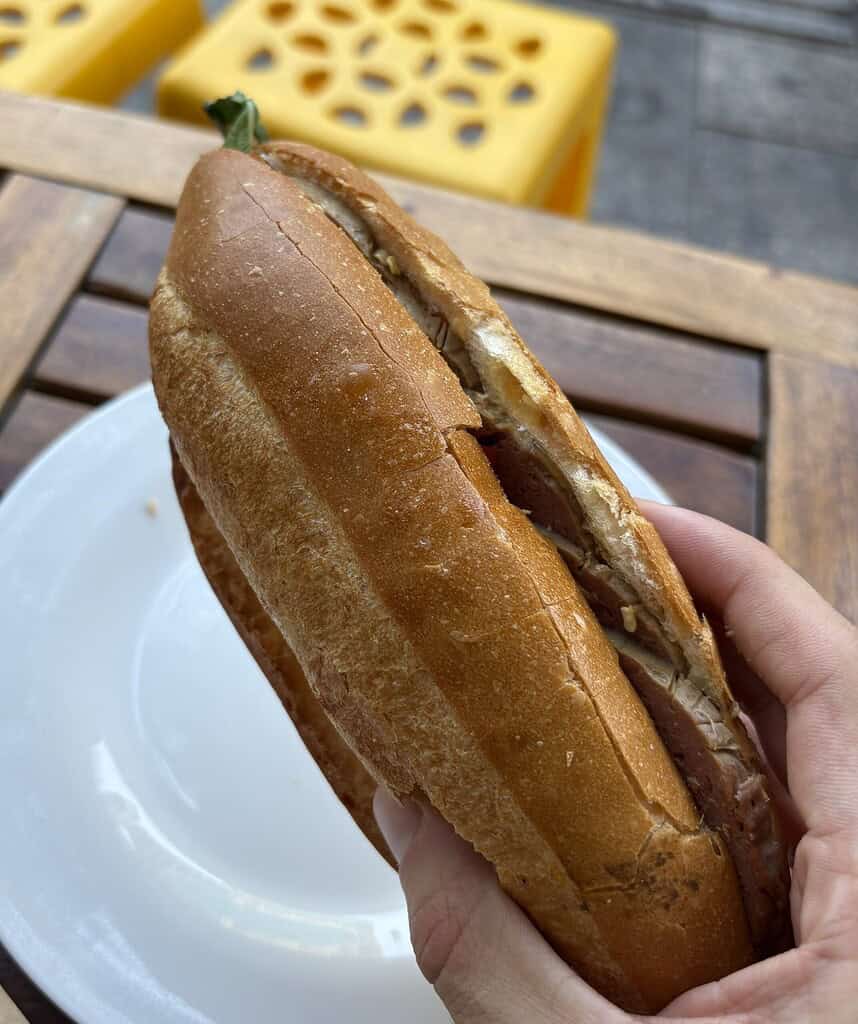
Final Thoughts on the Best Banh Mi in Vietnam
Banh mi isn’t just one of Vietnam’s most famous dishes, it’s a way of life. You’ll quickly notice how deeply woven it is into the everyday culture.
Whether it’s breakfast on the go, a mid-day bite, or a quick dinner after a long day, banh mi is the go-to option for many locals. It’s fast, flavorful, and always satisfying.
One of my favorite travel moments happened in Saigon. I saw a couple parked on the side of the road, making banh mi sandwiches right from the back of their scooter.
They had all their ingredients laid out, grabbing toppings and assembling the sandwiches with practiced speed and rhythm, getting them ready to sell.
After you’ve tried some of the best banh mi in Vietnam, make sure to explore the must-try Vietnamese coffees, each cup offers a unique and delicious experience that’s just as much a part of the culture.
It was such a raw and authentic scene, and it really cemented for me just how essential and iconic this sandwich is in Vietnam.
So when you’re here, try the famous spots, stumble into a few hidden gems, and eat more banh mi than you think you should. Trust me, you won’t regret it.
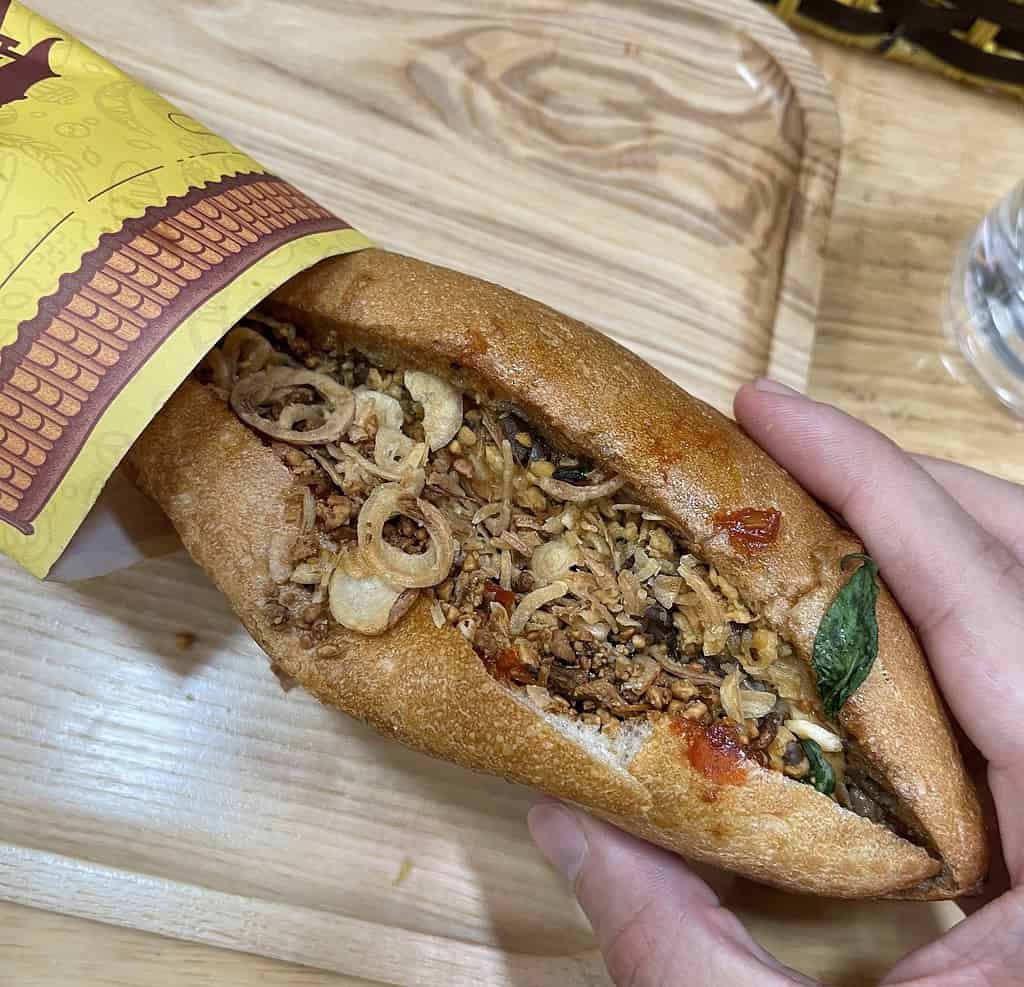
What is the best city in Vietnam to try banh mi?
While banh mi is found all over the country, Saigon (Ho Chi Minh City) is often considered the best place for variety, bold flavors, and sheer volume of options. That said, Hoi An has some incredibly famous shops, and Hanoi offers a simpler, more traditional take.
What is typically inside a Vietnamese banh mi?
A classic banh mi includes a crispy baguette, layers of pork cold cuts or grilled meat, pate, pickled vegetables, fresh cilantro, sliced chili, and a house-made sauce. Variations include meatballs, omelets, tofu, and even fish or tuna.
Is banh mi in Vietnam safe to eat from street vendors?
Yes, in most cases, banh mi from street vendors are safe, especially if the stall is busy with locals and the ingredients are prepped fresh.
How much does a banh mi usually cost in Vietnam?
Banh mi is incredibly affordable. On average, a sandwich will cost anywhere from 15,000 VND to 40,000 VND (less than $2 USD), depending on the location, ingredients, and portion size.

